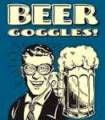April 2007
Reissdorf Kolsch
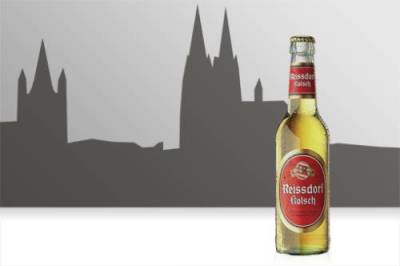
Kolsch is more then just a beer, it is a dialect, and it is the identity of the people of Cologne (Koln) Germany. Cologne has always seen itself as a separate entity within Germany, a city state. Settled by the Romans nearly 2,000 years ago, Cologne takes its name from the Roman word for “colony”. Cologne was a roman outpost, a boundary of the Roman Empire. This was the dividing line between the last bastion of ordered civilization and the world of barbarian Germanic tribes that could be found across the Rhine river. Today Cologne is known as the birthplace of cologne fragrance and the location of the majestic Dom cathedral built in the French gothic style. The 7,000 square meter cathedral took 632 years to complete. The church is the city’s largest tourist attraction and underlines Cologne’s Roman Catholic roots.
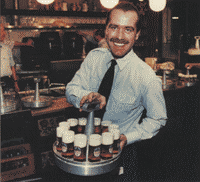 The term Kolsch was officially used for the first time in 1918 to describe the type of beer that had been brewed by the Sunner brewery. The Kolsch style of beer is top-fermented, meaning that it is fermented rather quickly at 15 to 20c causing the yeast to rise to the top. As opposed to Pilsners which are bottom fermented beers which ferment slowly at much cooler temperatures. Kolsch is lightly hopped, pale straw coloured ale that takes its name from the Cologne dialect word meaning “of Cologne”. It’s a light refreshing beer sometimes brewed with a touch of wheat malt. The flavor can be quite sweet from the malt and bitter from the hops. Kolsch beer is served in special cylindrical glasses called “Stangen” (pole). In Kolsch slang, these glasses are also called, “Reagenzglas” which translates to “test tube”. The cylindrical glasses traditionally hold 0.2 litres, however lately 0.3l and even 0.4l sizes have been made available to quench the locals’ ever growing thirst.
The term Kolsch was officially used for the first time in 1918 to describe the type of beer that had been brewed by the Sunner brewery. The Kolsch style of beer is top-fermented, meaning that it is fermented rather quickly at 15 to 20c causing the yeast to rise to the top. As opposed to Pilsners which are bottom fermented beers which ferment slowly at much cooler temperatures. Kolsch is lightly hopped, pale straw coloured ale that takes its name from the Cologne dialect word meaning “of Cologne”. It’s a light refreshing beer sometimes brewed with a touch of wheat malt. The flavor can be quite sweet from the malt and bitter from the hops. Kolsch beer is served in special cylindrical glasses called “Stangen” (pole). In Kolsch slang, these glasses are also called, “Reagenzglas” which translates to “test tube”. The cylindrical glasses traditionally hold 0.2 litres, however lately 0.3l and even 0.4l sizes have been made available to quench the locals’ ever growing thirst.
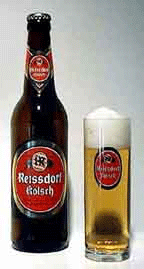 Freshness is a very important factor in Kolsch beer. As the beer is brewed within city limits there is not a lot of travel involved. Also because of the small drinking vessel of 0.2l, you are never left with flat beer or a warm ending to a pint. The amount of beer orders is also heightened as a result of the small traditional glasses therefore interaction with the beer server is quite frequent. The servers of Kolsch are called “Kobes”, traditionally clad in a blue shirt, dark trousers and apron. These Kobes patrol the bars and beer gardens with a keen eye, constantly bringing new beers to thirsty customers, as the 0.2l Kolsch glasses are emptied. The 0.2l glasses are carried by the Kobes in a circular tray called a Kolshkranz. The Kolshkranz has holes for the glasses and a handle in the centre. It is seen as rude to attract the attention of a Kobes and ask for a Kolsch. Instead you should grab a seat and wait for the beer to be offered to you. The Kobes will usually make a mark on your beer coaster for each beer purchased. If you have had your last beer, sitting the beer coaster on top of the finished glass signals the Kobes to not bring you a new one. The Kobes are known for their brash humor often sharing in dirty jokes and yuking it up with customers. Also until recently, the Kobes would share a drink with the customers, now unfortunately this is not the case. A law was passed banning this practice.
Freshness is a very important factor in Kolsch beer. As the beer is brewed within city limits there is not a lot of travel involved. Also because of the small drinking vessel of 0.2l, you are never left with flat beer or a warm ending to a pint. The amount of beer orders is also heightened as a result of the small traditional glasses therefore interaction with the beer server is quite frequent. The servers of Kolsch are called “Kobes”, traditionally clad in a blue shirt, dark trousers and apron. These Kobes patrol the bars and beer gardens with a keen eye, constantly bringing new beers to thirsty customers, as the 0.2l Kolsch glasses are emptied. The 0.2l glasses are carried by the Kobes in a circular tray called a Kolshkranz. The Kolshkranz has holes for the glasses and a handle in the centre. It is seen as rude to attract the attention of a Kobes and ask for a Kolsch. Instead you should grab a seat and wait for the beer to be offered to you. The Kobes will usually make a mark on your beer coaster for each beer purchased. If you have had your last beer, sitting the beer coaster on top of the finished glass signals the Kobes to not bring you a new one. The Kobes are known for their brash humor often sharing in dirty jokes and yuking it up with customers. Also until recently, the Kobes would share a drink with the customers, now unfortunately this is not the case. A law was passed banning this practice.
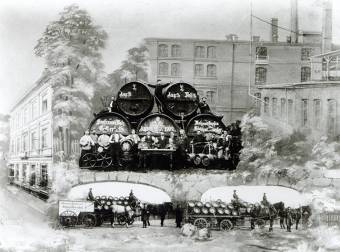
 Kolsch beer has been brewed in the region of the Rhine since 874. Still to this day, only breweries, which have a view of the Cologne Dom, can brew Kolsch style beer, it’s the law. It might seem odd but it’s true, Kolsch is the only beer that may not be brewed outside the Cologne region, as determined by the Kolsch Convention of 1986. Twenty-four breweries in Cologne agreed to a sort of “appellation controllee” that a beer could only be called “Kolsch” if it met the following criteria:
Kolsch beer has been brewed in the region of the Rhine since 874. Still to this day, only breweries, which have a view of the Cologne Dom, can brew Kolsch style beer, it’s the law. It might seem odd but it’s true, Kolsch is the only beer that may not be brewed outside the Cologne region, as determined by the Kolsch Convention of 1986. Twenty-four breweries in Cologne agreed to a sort of “appellation controllee” that a beer could only be called “Kolsch” if it met the following criteria:
- brewed in Cologne
- top fermented
- pale colour
- hop-accented
- filtered
- is a “vollbier” (has an original wort extract (gravity) between 11% and 14%
In 1997 Kolsch became a protected designation of origin, expanding this protection to the entire EU. Nevertheless many brands abroad especially in the US and Japan use the word, as it is not illegal in local law. Also exclusiveness is frowned upon by the Kolsch drinking crowd. There is actually a deal between the breweries that no Kolsch will be sold with any extra titles like “Premium”, “Special” or “Extra high quality”. Karl Marx the communist philosopher once famously said that his revolution could not work in Cologne, since the bosses went to the same pubs as their workers.


Cologne has more breweries than any other city in the world. Out of the twenty odd Kolsch breweries, the largest one is Reissdorf Kolsch. It has a large and loyal following bordering on a cult. There are Reissdorf fan clubs, clothing, PC screen savers, cell phones. 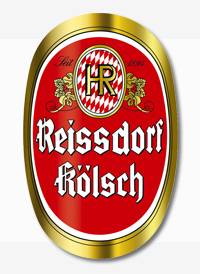 People even dress up as the Reissdorf Kolsch bottle during the Cologne Carnival. The brewery was established in 1894 by Heinrich Reissdorf in the historic “Severinsviertel” district, in the centre of Cologne. After Heinrich’s death in 1901, his wife Gertrude took over with the help of their five sons; Johann Hubert, Heinrich, Hermann, Friedrich and Carl. The brewery was the first to sell Kolsch beer in bottle form in 1936. All the Reissdorf sons were drafted into the German army during WWII and following the breweries destruction during the war, it had to be rebuilt in 1945. The Rhine, a very important industrial area, was targeted by allied forces. The city of Cologne was flattened and all that was left standing was the Dom cathedral. In 1998 a new state-of-the-art, computer controlled, stainless steel brewery was built on the outskirts of Cologne, in an area named Rodenkirchen. As a result, Reissdorf Kolsch has helped pioneer the modern style of Cologne's local specialty.
People even dress up as the Reissdorf Kolsch bottle during the Cologne Carnival. The brewery was established in 1894 by Heinrich Reissdorf in the historic “Severinsviertel” district, in the centre of Cologne. After Heinrich’s death in 1901, his wife Gertrude took over with the help of their five sons; Johann Hubert, Heinrich, Hermann, Friedrich and Carl. The brewery was the first to sell Kolsch beer in bottle form in 1936. All the Reissdorf sons were drafted into the German army during WWII and following the breweries destruction during the war, it had to be rebuilt in 1945. The Rhine, a very important industrial area, was targeted by allied forces. The city of Cologne was flattened and all that was left standing was the Dom cathedral. In 1998 a new state-of-the-art, computer controlled, stainless steel brewery was built on the outskirts of Cologne, in an area named Rodenkirchen. As a result, Reissdorf Kolsch has helped pioneer the modern style of Cologne's local specialty.
All Kolsch brewed by Reissdorf uses German grown barley, with both pilsner and Munich malts employed in the mash. The bittering hops are Magnum, and for aroma Perle and Hallertau varieties are used. The beer ferments for three days and is lagered for two weeks. Reissdorf Kolsch is light golden in colour with a clean, slightly floral nose, and a hint of sweetness. It pours with a lively and attractive white head. The beer tastes of fruit, honey with a slightly malty, fairly soft full bodied palate. There is an initial hint of banana flavours in the malt, a biscuity honey character and plenty of delicate flowery hops. Both whole hops and extract are used. The finish is sharp and accented with a spicy aroma of hops, due to its high hop character. It’s nice and smooth and refreshing to drink.
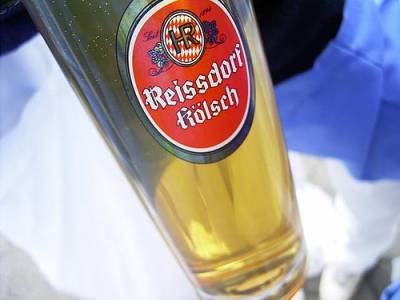
To this day Reissdorf Kolsch remains a family owned independent brewery. In fact today it is operated by the fourth generation of the Reissdorf family. This is a large accomplishment in a market where breweries are constantly changing hands. Reissdorf’s tradition of pride and quality feeds its cult status with beer connoisseurs from all over the world. However ninety-nine percent of all Reissdorf Kolsch is sold in the Cologne region. Exports are obviously a small part of the breweries sales. As a result, Reissdorf Kolsch is seen as a “well preserved secret.” Not anymore, the secret it out. But where can you find this delicious stuff? I myself have had it only in Cologne, or when friends bring it over with them when visiting. During my research I read that there is a restaurant in Beijing, China that carries it. In the United States Reissdorf Kolsch is imported by B. United International of Redding CT.
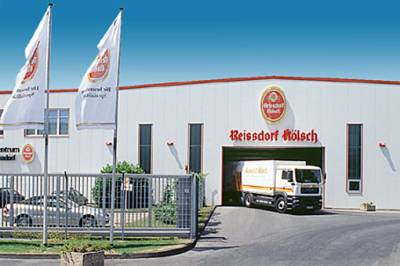
For more information on Reissdorf Kolsch go to:
© 2006 (MR) roecken.ca
